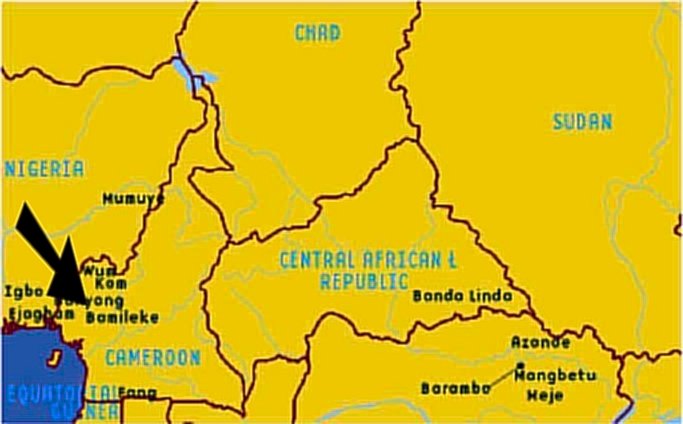
| GRASSLANDS Cameroon |
| The most important Cameroon grasslands kingdom in the south is the Bamileke circle (Batcham, Bandjoun, Bangwa, and others). There are one million Bamileke spread over the plateaus, in communities that have from 50,000 to 100,000. Art objects were symbols of high position in the hierarchy. The buffalo’s physical power and endurance was viewed as a particularly appropriate metaphor for the force of palace law, but ranked below the elephant and leopard. The buffalo masks were worn by palace regulators in their roles as market police, apprehenders of wrongdoers, and court judges. According to S. P. Blier, “Some of the masked performers were perceived to be so wild and dangerous that they had to be restrained by ropes to prevent them from doing harm, a display that would have reinforced the original functions of these court maskers in punishing those guilty of criminal acts”. Sources: A History of Art in Africa / Africa - The Art of a Continent / The Tribal Art of Africa |
| This piece is not in my collection Click on any picture to see larger version. |
| Examples below for reference purposes |
| Sotheby's - Paris Paolo Morigi collection : Important African Art Auction Date : Jun 6, 2005 Lot 164 : f - IMPORTANT MASQUE-HEAUME, BAMILÉKÉ, CAMEROUN An important Bamileke helmet mask, Cameroon PROVENANCE Simone de Monbrison, Paris. Ancienne collection G.F. Keller (inv. G.F.K. 224) An important Bamileke helmet mask, Cameroon Among the zoomorphic masks of the Cameroon Grasslands, buffalo masks are considered the most powerful: 'symbols of force, of courage and of power', according to Harter (1986:44). In the Grasslands, just as amongst their neighbors, (Duala, Mama), the buffalo is a symbol of the chief. Therefore, according to Harter ( ibid.) the buffalo hunt was reserved only for the fon (king) in the Grasslands. Amongst the Bamum, the buffalo mask was the first to appear at the annual festival, nja, expressing ' solidarity, wealth and the social role of the Bamum' (Geary, 1984: 138-142). The buffalo helmet mask was worn by a nephew of the king, chosen as 'the preferred servant of the court' (ibid.). While buffalo masks are found throughout the entire Grasslands in Cameroon, few representations of buffalo are known from the Bamileke. According to Harter (1986 : 45), "Within the Bamiléké tribe, aside for the numerous masks representing horned anthropomorphic creatures meant for a portion of the ku n'gan society, the bovine masks are rare and, in general, unique to each tribe. The buffalo helmet served only for the one who represents the fon during the ngou dance ". The patina on the Morigi helmet attests to years of traditional use. This quality is underlied by the extraordinary dimensions and the power in the sculpture. Dimensions haut. 95 cm 37 1/2 in Estimate:€ 60,000 - € 90,000 Price Realized:€ 102,000 / $ 122,892 |
| Sotheby's - New York African and Oceanic Art Auction Date : Nov 16, 2001 Lot 146 : A superb Bamileke buffalo mask Description A superb Bamileke buffalo mask of hollowed helmet-like form representing a buffalo with open mouth baring teeth, the flared nostrils beneath wide-set almond-shaped eyes framed by protruding ears and arching horns; encrusted blackened patina. height 18in. (45.7cm.) Published: Anderson and Kreamer 1989: 144, figure 120 Exhibited: New York, The Center for African Art, Wild Spirits, Strong Medicine, May 10-August 20, 1989 (for additional venues see bibliography) Estimate:$ 5,000 - $ 7,000 Price Realized:$ 0 |

| Sotheby's - New York African and Oceanic Art Auction Date : Nov 16, 2001 Lot 4A : A fine Cameroon buffalo mask Description A fine Cameroon buffalo maskof hallowed, helmet-like form the buffalo's head with open mouth baring teeth beneath the large flaring nostrils leading to a medial ridge, the far-set almond-shaped eyes framed by small c-shaped ears surmounted by large, arching horns decorated with linear motifs; exceptionally fine blackened and encrusted patina. length 29 in. (74.9 cm.) Dimensions length 29 in. (74.9 Estimate:$ 8,000 - $ 12,000 Price Realized:$ 7,200 Provenance Harry A. Franklin, Los Angeles Sotheby's, New York, April 12, 1990, lot 144 |







